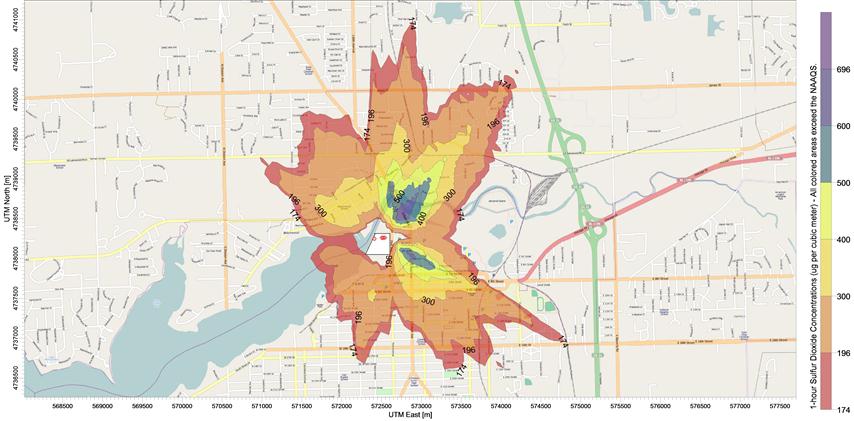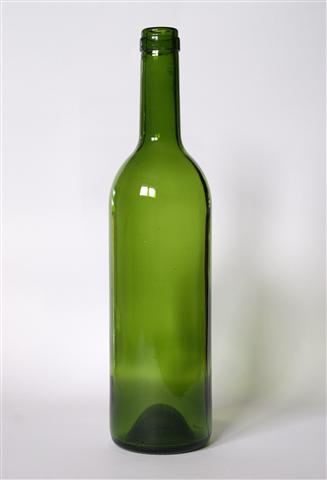Recent Projects by Wingra Engineering

Wingra Evaluates Power Plant
Compliance with New SO2 Air Quality Standard
 On
June 2, 2010, EPA lowered the National Ambient Air Quality
Standard (NAAQS) for sulfur dioxide (SO2).
The new standard is expected to improve public health protection,
especially for children, the elderly, and people with
asthma. In 2011, Wingra Engineering evaluated
over fifty U.S. power plants to help USEPA, state and
local air agencies identify facilities not complying with the new
air quality standard. The power plants were located in numerous
states including Maine, New Hampshire, Massachusetts,
Pennsylvania, New York, Connecticut, Maryland,Virginia, West
Virginia, Kentucky, Washington, D.C., Indiana, Michigan,
Wisconsin, Missouri, Kansas and Nebraska.
On
June 2, 2010, EPA lowered the National Ambient Air Quality
Standard (NAAQS) for sulfur dioxide (SO2).
The new standard is expected to improve public health protection,
especially for children, the elderly, and people with
asthma. In 2011, Wingra Engineering evaluated
over fifty U.S. power plants to help USEPA, state and
local air agencies identify facilities not complying with the new
air quality standard. The power plants were located in numerous
states including Maine, New Hampshire, Massachusetts,
Pennsylvania, New York, Connecticut, Maryland,Virginia, West
Virginia, Kentucky, Washington, D.C., Indiana, Michigan,
Wisconsin, Missouri, Kansas and Nebraska.
Dispersion modeling analyses were conducted following USEPA
approved procedures. Computer models included AERSURFACE to
evaluate land use, AERMAP to evaluate terrain elevations, AERMET
to process recent meteorological data, and AERMOD to predict down
wind concentrations. Operating scenarios were based on SO2
emissions approved by the
most recent air quality permit and historical actual emissions as
measured by continuous emission monitors on the boiler stacks. Air
pollution emission reductions necessary to comply with the new
standard were calculated and predicted air pollutant
concentrations were over laid onto regional and local maps to help
present
the modeling results to regulatory agencies and the general
public.
Wingra Obtains Environmental
Approvals for Wine Bottle Manufacturing Plant
in Washington
In
2010, Wingra Engineering coordinated environmental approvals to
re-open a wine bottle
manufacturing plant in Kalama, Washington. The existing
glass furnace was replaced with a new electrically-assisted,
oxygen-fired melting furnace which reduced nitrogen oxide (NOx)
emissions by 90% compared to traditional container glass
furnaces. Wingra worked with the German furnace and air
pollution control system manufacturers to assure compliance with
federal, state and local air pollution control requirements. The
project design reduced emissions below minor air pollution
source thresholds so only local permit approval by the Southwest Clean Air Agency
was required. Besides obtaining the local air quality permit,
Wingra verified the project met state environmental policy act
requirements. The plant is
expected to open during the summer
of 2012.
Wingra Helps Develop
Environmental
Management System in Wisconsin
In 2009, Wingra Engineering worked with a coated and insulated
glass manufacturer in Wisconsin to help develop their Environmental
Management
System or EMS. Each activity at the facility was reviewed to
determine raw material and energy consumption; environmental
impacts
include waste generation and pollution discharges; applicable laws
and
regulations; and, compliance with these requirements. Past
improvements
were documented and goals for future improvements were outlined.
This
summary of environmental impacts and register of legislation
became the
starting point for the company's EMS.
Wingra
Evaluates
Sites for New Manufacturing Plant in Southwest U.S.
In 2008, Wingra Engineering investigated the air pollution
control
requirements for potential sites of a new flat glass and solar
photovoltaic cell manufacturing plant in the
southwest U.S. including Arizona, New Mexico and Nevada. The
evaluation
considered the air pollution emissions from the facility;
jurisdictions
of local and state air pollution control agencies; proximity of
nonattainment areas which did not comply with air quality
standards;
and, nearby national parks and wilderness areas. Additional air
pollution control measures were developed by Wingra and then
incorporated into the project to reduce discharges and expand the
range
of acceptable plant locations.
Wingra
Obtains Air Quality Permit for Foundry Expansion in Tennessee
In 2007, Wingra Engineering obtained an air quality permit from
the Tennessee Department of Environmental Conservation for the
expansion of an iron
foundry in Etowah,
Tennessee. New electric furnaces and casting lines with a
capacity of 60 tons per hour would be constructed. Beside the
state air pollution control agency, Wingra worked with the
National Park Service and U.S. Forest Service to assure protection
of sensitive areas such as Smokey Mountains National Park. The new
equipment required approval under the Prevention
of
Significant
Deterioration or PSD major source
regulations. Wingra prepared a permit
application for the project that included an evalution of
state-of-the-art air pollution control measures and dispersion
modeling
analyses to verify compliance with air quality standards.
Wingra Obtains Air
Quality Permit for Coal-Fired Lime Kiln in Wisconsin
In 2006, Wingra Engineering successfully obtained
an
air quality permit for a new 650 ton per day coal-fired lime
kiln to be
located in
Superior,
Wisconsin. The kiln was subject to the Prevention of
Significant Deterioration air quality regulations including an
evaluation of Best Available Control Technology (BACT) and
near-field
air quality impacts. All air pollutants were controlled using
BACT or state-of-the-art air pollution control methods.
These
included the use of a fabric filter baghouse for the capture of
dust
from the kiln and materials handling operations, and use of low
sulfur
coal and a preheater type kiln to neutralize sulfur dioxide
emissions
by 92%. Combustion related air pollutants including nitrogen
oxides and
carbon monoxide were controlled by the use of a preheater lime
kiln
which reduced both energy usage and resulting stack emissions by
over
30% compared to the conventional lime kilns. The project was
designed
to assure nearby air quality impacts were insignificant for all
air
pollutants. Approval was obtained from the U.S. Forest Service
by
demonstrating that impacts on nearby Class I Air Quality Areas
including the Boundary Waters Canoe Area Wilderness and the
Rainbow
Lake Wilderness were insignificant.
Wingra Receives
Approval of First Combined Risk Analysis
Wisconsin hazardous air pollutant requirements
under
Chapter NR 445, Wis. Adm. Code, were recently changed to allow
use of a
combined risk analysis as a compliance method for carcinogenic
air
pollutants. In 2005, Wingra Engineering received the first Wisconsin Department of Natural Resources approval of a combined risk analysis for discharges
from an
iron foundry. A comprehensive emissions inventory was compiled
for 16
individual contaminants released from 82 foundry operations,
emergency
generators and natural gas combustion. To simplify the analysis,
emissions from each discharge point were reduced to an
equivalent
quantity of benzene emissions, referred to as “TEQ as Benzene”.
The
analysis verified that the estimated cumulative risk due to
foundry
operations was less than the 10 x 10-6
requirement. A technical paper on the techniques used for this
project
was presented at the national conference of the Air & Waste
Management Association in 2006. An abstract and full text of the
paper
are available on the Wingra web
site.
Wingra Successfully
Challenges Air Permit Issuance
In 2005, Wingra provided expert witness services
to
represent neighborhood residents challenging issuance of an air
quality
construction permit for melting furnaces at an aluminum die
caster and
foundry. During a five day contested case hearing, it was
demonstrated
that close proximity of residents to the foundry required more
accurate
dispersion modeling procedures. The Wisconsin Department of
Natural
Resources had failed to consider the effects of the downwash
recirculation cavity, terrain and fugitive emissions from open
doors
and windows. As a result, facility discharges violated air
quality
standards in the backyards of surrounding homes. In his
decision, the
hearing examiner amended the permit to require the foundry to
eliminate
all fugitive emissions and operate two air quality monitors in
areas
predicted to exceed air quality standards. Rather than implement
these
additional air pollution control measures, the company
subsequently had
the DNR revoke the permit.
Wingra obtains Air Quality Approvals
for
a Washington State Float Glass
Plant
near
Mount
Rainier
and
Olympic National Parks
In 2004, Wingra Engineering successfully obtained air
quality
permits for a 650 ton per day float glass plant in Washington
State.
This plant used a 200 mmbtu per hour natural gas fired
regenerative
furnace to melt sand, limestone and other raw materials to
generate a
continuous 16 foot wide ribbon of flat glass for windows and
other
glass applications. The project required approval by the local
air
quality agency, Washington Department of Ecology, and oversight
by the
U.S Environmental Protection Agency, U.S. Forest Service, and
National
Park Service. Locating a new air pollution source near national
parks
and wilderness areas increases the need for a more thorough
evaluation
of air quality impacts and available emission control methods.
The project required
issuance of a Prevention of Significant Deterioration (PSD) air
quality
permit requirements including an evaluation of Best Available
Control
Technology (BACT) and near-field air quality impacts. As BACT,
the
plant was equipped with air pollution control systems for the
control
of PM, SO2 and NOx emissions. A spray
drier -
electrostatic precipitator was used to control PM and SO2
emissions. NOx was controlled using the 3R
Process,
a combustion technique unique to regenerative furnace float
glass
plants which uses excess natural gas to create a reducing
atmosphere,
similar to the reburn process used in coal-fired boilers.
Due to complex
terrain
near the project site, a more accurate near-field modeling
analysis was
conducted using the AERMOD dispersion model and meteorological
data
collected near the site. Project impacts were below the
significant
impact levels for all air pollutants except NOx. As a
result, a regional inventory of NOx emissions sources was
developed to
model the combined impact from the project and surrounding
emission
sources, and verify compliance with air quality standards.
As Washington State
does not have a SIP-approved PSD program, USEPA Region 10
provided
additional review to verify compliance with the PSD regulations.
The project was
located
within 200 kilometers of seven Class I air quality areas
including
Mount Rainier and Olympic National Parks. A separate evaluation
was
required by the National Park Service and U.S. Forest Service to
assess
far-field impacts on air quality standards, and air quality
related
values including regional visibility and acid deposition.
Far-field
impacts were estimated using the CALPUFF model. The project was
determined to have insignificant impacts for all air quality
standards
and AQRV.
While prior float
glass
projects elsewhere in the U.S. had established BACT for the
industry
without the use of add-on control equipment, the proximity to
the Class
I areas required greater control of plant air pollution
emissions.
Additional control measures included use of a spray
drier-electrostatic
precipitator control system for glass furnace PM and SO2
emissions and a selective catalytic reduction system to control
NOx
emissions from backup emergency generator.
A technical paper on the
techniques used for this project was presented at the national
conference of the Air & Waste Management Association in
2006. An
abstract and full text of the paper are available on the Wingra
web
site.

 On
June 2, 2010, EPA lowered the National Ambient Air Quality
Standard (NAAQS) for sulfur dioxide (SO2).
The new standard is expected to improve public health protection,
especially for children, the elderly, and people with
asthma. In 2011, Wingra Engineering evaluated
over fifty U.S. power plants to help USEPA, state and
local air agencies identify facilities not complying with the new
air quality standard. The power plants were located in numerous
states including Maine, New Hampshire, Massachusetts,
Pennsylvania, New York, Connecticut, Maryland,Virginia, West
Virginia, Kentucky, Washington, D.C., Indiana, Michigan,
Wisconsin, Missouri, Kansas and Nebraska.
On
June 2, 2010, EPA lowered the National Ambient Air Quality
Standard (NAAQS) for sulfur dioxide (SO2).
The new standard is expected to improve public health protection,
especially for children, the elderly, and people with
asthma. In 2011, Wingra Engineering evaluated
over fifty U.S. power plants to help USEPA, state and
local air agencies identify facilities not complying with the new
air quality standard. The power plants were located in numerous
states including Maine, New Hampshire, Massachusetts,
Pennsylvania, New York, Connecticut, Maryland,Virginia, West
Virginia, Kentucky, Washington, D.C., Indiana, Michigan,
Wisconsin, Missouri, Kansas and Nebraska. 
